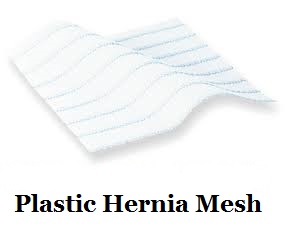 Most people considering surgery for hernia repair will find themselves facing a difficult choice. Of course, one can always “wait and see” in the event of a hernia (more on that below). And it is sometimes possible to use belts or trusses to help manage or simply live with a hernia. Most people suffering from a hernia, however, will likely face a choice of surgical options. Most will decide whether it is best to choose a plastic hernia mesh to repair a hernia, or to find a surgeon who can perform a more traditional hernia repair using sutures and/or natural tissues.
Most people considering surgery for hernia repair will find themselves facing a difficult choice. Of course, one can always “wait and see” in the event of a hernia (more on that below). And it is sometimes possible to use belts or trusses to help manage or simply live with a hernia. Most people suffering from a hernia, however, will likely face a choice of surgical options. Most will decide whether it is best to choose a plastic hernia mesh to repair a hernia, or to find a surgeon who can perform a more traditional hernia repair using sutures and/or natural tissues.What is a Hernia?
A hernia occurs when an organ, intestine or fatty tissue breaches a weak spot or a hole in muscle or connective tissue. Hernias often occur at the abdominal wall. Sometimes a hernia can be visible as an external bulge, particularly when one strains or bears down. There are many types of hernias, but inguinal hernias – in the groin area – are by far the most common.
Hernia Types
• Inguinal: inner groin
• Femoral: upper thigh/outer groin
• Incisional: incision or scar breach in the abdomen
• Ventral: general abdominal/ventral wall
• Umbilical: belly button
• Hiatal: inner abdominal, along the upper stomach/diaphragm
Hernia Causes
Most hernias are caused by a combination of pressure and an opening or weakness of muscle or connective tissue. Pressure pushes an organ or tissue through the opening or weak spot. The muscle weakness can be present at birth, but it usually occurs later in life. Anything that increases abdominal pressure can cause a hernia. Risk factors include obesity, heavy lifting, diarrhea, constipation, persistent coughing, sneezing. The FDA web site notes that poor nutrition, smoking, and overexertion can also weaken muscles and contribute to hernia risk.
Hernia Treatment Options
The FDA reports that more than one million hernia repairs are performed each year in the U.S. About 80% involve inguinal hernias. Treatment options are myriad.
1. Non-Surgical
Watchful Waiting – One can watch a hernia to see that it is not getting larger or causing problems. Though surgery is the only treatment that can repair hernias, many surgical procedures are elective for adult inguinal hernias. Watchful waiting is an option for people who do not have complications or symptoms with their hernias, and if recommended by their surgeon.
2. Surgical
a. Laparoscopic – A surgeon makes several small incisions in the abdomen that allow surgical tools in for repair. Laparoscopic surgery can be performed with or without surgical mesh.
b. Open Repair – A surgeon incises near the hernia and repairs the weak muscle area. Open repair can be done with or without mesh. Open repair using sutures without mesh is referred to as primary closure. Primary closure, says FDA, is used primarily to repair inguinal hernias in infants, small hernias, strangulated or infected hernias. But one can use primary closure for other reasons, as well (such as fear of hernia mesh and its “side effects”), though the FDA does not say so.
The Problems of Surgical Mesh for Hernia Repair
The FDA on its web site seems solidly in favor of surgical mesh for hernia repair. At the same time, it is worth noting that the agency also backed – at least in the beginning – the use of plastic mesh on women suffering from pelvic organ prolapse (POP) or stress urinary incontinence (SUI). The agency’s confidence in mesh appears to have been misplaced for many women. More than 100,000 have filed lawsuits alleging they were injured by the plastic mesh used on them. Many thousands of those lawsuits were settled, while many of them remain in the courts. Just a few weeks ago, a jury awarded a woman several million dollars for a Johnson & Johnson mesh product that she testified badly injured her. Several mesh trials resulted in large jury verdicts, including a recent $73 million award in Dallas. The material used in the mesh on that injured Texas woman – along with thousands of others for POP or SUI – is the same material used in hernia meshes.
The FDA reports on its web site that mesh-based hernia repairs have increased since the 1980s. By 2000, non-mesh repairs made up less than 10% of groin hernia repair techniques. Does that mean that hernia mesh is safe? Not according to at least one surgeon, who says that 10-20% of hernia mesh patients suffer complications.
FDA also says “the use of surgical mesh may also improve patient outcomes through decreased operative time and minimized recovery time.” But FDA also cautions that recovery time depends on the type of hernia, the surgical approach, the patient’s condition before and after surgery.
The agency also says that the medical literature has “consistently demonstrated a reduced hernia recurrence rate when surgical mesh is used to repair the hernia compared to hernia repair without surgical mesh. For example, inguinal hernia recurrence is higher with open repair using sutures (primary closure) than with mesh repair.” But does that mean hernia mesh is safer than suturing, or superior to suturing?
FDA Cautions on Hernia Mesh
The FDA also admits that. despite reduced rates of recurrence with hernia mesh vs. suture repairs, situations arise in which surgical mesh for hernia repair “may not be recommended. Patients should talk to their surgeons about their specific circumstances and their best options and alternatives for hernia repair.”
Hernia Mesh vs. Suture Repair
While the literature may indicate that using mesh for hernia repairs does have its advantages, the FDA categorically fails to state one glaring fact for those whom the mesh fails. At least one prominent hernia surgeon says that the complication rate for hernia mesh surgery is a shocking 10-20%. The FDA also fails to state, in its hernia mesh literature, what we saw with plastic mesh used on women for POP or SUI. Namely, if the mesh fails the patient, for whatever reason, it can be difficult or impossible to remove it. That unfortunate situation can lead to permanent pain for the person meshed.
Related
- Hernia Mesh 10-20% Complication Rate, says Surgeon
- Hernia Mesh Lawsuit
- Ethicon Hernia Mesh Lawsuit
- Physiomesh Lawsuit / Hernia Mesh Attorney
- Ten Deaths Linked with Hernia Mesh
- Hernia Mesh: Reporting Problems to FDA
- Counterfeit Hernia Mesh Recall – FDA

by Matthews & Associates




